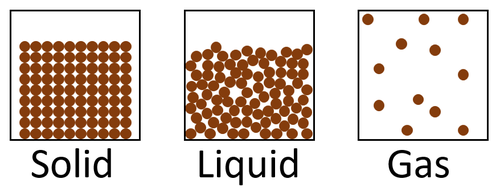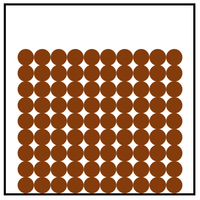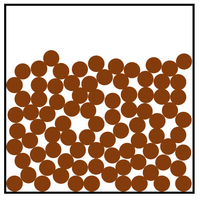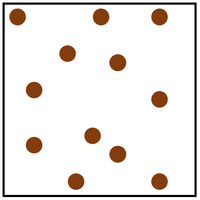Contents
Key Stage 3
Meaning
The particle model is a scientific theory that explains the properties of solids, liquids and gases by suggesting that all matter is made of particles, and that those particles behave differently in solids, liquids and gases.
| A diagram showing the particle model for solids, liquids and gases. |
About The Particle Model
- The particle model explains the properties of solids, liquids and gases.
- The particle model can explain changes of state.
- Evidence of the particle model can be shown by pouring 50ml of pure water and 50ml of pure ethanol into a measuring cylinder. The solution is only 97ml because ethanol molecules are bigger than water molecules so the water molecules fit between the ethanol molecules like pouring 50ml of sand and 50ml of marbles into the same container. It will not make 100ml.
- Evidence of the particle model can be shown by observing Brownian Motion.
Key Stage 4
Meaning
The particle model is a scientific theory that explains the properties of solids, liquids and gases by suggesting that all matter is made of particles, and that those particles behave differently in solids, liquids and gases.
About The Particle Model
- The particle model describes how the particles that make a solid, liquid or gas are arranged and how they move.
- In the particle model the particles are constantly moving and colliding with one another.
- The particles have kinetic energy which is passed on to each other during collisions.
| Diagram | Arrangement | Motion |
| In a solid the particles are in a regular arrangement and very close together. This is the most dense state of matter. | In a solid the particles vibrate around fixed positions. | |
| In a liquid the particles are in a random arrangement with small gaps between them. | In a liquid the particles can slide past one another. | |
| In a gas the particles are in a random arrangement and spread far apart from one another. This is the least dense state of matter. | In a gas the particles are free to move in all directions. |
Limitations of the Particle Model
- The particle model is not a complete explanation for the properties of a material. However, it is a useful approximation which can make predictions about the properties of solids, liquids and gases, that is not perfect.
- The particle model only explains the properties of solids, liquids and gases but not why different materials are solid, liquid or gas at different temperatures.
The problems with the particle model are that it makes several assumptions which are not always the case:
| Assumption | Reality | Problem |
| Particles are spheres. | Particles are often molecules whose shape is not a sphere, some of which are long chains of atoms. |
|
| There are no forces between particles. | There are forces between atoms and intermolecular forces between molecules. |
|
| The size of all particles in a substance is the same. | A substance can be made of more than one different particle which have different sizes. |
Chemical Reactions in the Particle Model
- During a chemical reaction atoms are rearranged into new compounds. The particle model explains how temperature and pressure affect the rate of chemical reactions.
- In the particle model the particles collide with one another.
- If particles collide with enough kinetic energy it can break the chemical bonds holding the atoms to each other in a molecule.
- When collisions have caused molecules to break apart they can join back together in a new arrangement.
Temperature and Chemical Reactions
- When the temperature of a substance is increased it causes the particles to move around faster, with greater kinetic energy.
- As temperature increases the particles collide more often and with greater kinetic energy.
- When particles collide more often it means a greater chance of the chemical bonds breaking and atoms rearranging into new compounds.
- When particles have a large kinetic energy during a collision they are more likely to have enough energy to break the chemical bonds holding atoms in the molecules together.



